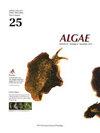Novel rearrangements in the mitochondrial genomes of the Ceramiales (Rhodophyta) and evolutionary implications
IF 2.4
3区 生物学
Q1 MARINE & FRESHWATER BIOLOGY
引用次数: 0
Abstract
The Ceramiales is the most diverse and species-rich group (2,669 spp.) of red algae, and it is widely distributed from tropical to polar oceans. Mitochondrial genomes (mitogenomes) and other genes have contributed to our knowledge regarding the classification and phylogeny of this diverse red algal group; however, the mitogenome architecture remains understudied. Here, we compared 42 mitogenomes, including 19 newly generated in this study, to expand our knowledge. The number of genes in mitogenome varied from 43 to 68 due to gene duplication. The mitogenome architecture was also variable, categorized into four types (A–D): type A = ancestral type with a basic composition; type B = those with inverse transpositions; type C = those with inverted duplications; and type D = those with both inversion and duplication. The palindromic and inverted repeats were consistently found in flanking regions of the rearrangement, especially near the cob and nad6 genes. The three rearranged mitogenome architectures (types B, C, D) are the first report of these in red algae. Phylogenetic analyses of 23 protein-coding genes supported the current familial classification of the Ceramiales, implying that the diversity of mitogenome architecture preceded the phylogenetic relationships. Our study suggests that palindromic and inverted repeats may drive mitogenome architectural variation.Ceramiales (Rhodophyta) 线粒体基因组的新重排及其对进化的影响
Ceramiales 是红藻中种类最多、物种最丰富的一个类群(2,669 种),广泛分布于从热带到极地的海洋中。线粒体基因组(有丝分裂基因组)和其他基因有助于我们了解这一多样化红藻类群的分类和系统发育;然而,对有丝分裂基因组结构的研究仍然不足。在此,我们比较了 42 个有丝分裂基因组,包括本研究中新生成的 19 个基因组,以扩展我们的知识。由于基因重复,有丝分裂基因组中的基因数量从 43 个到 68 个不等。有丝分裂基因组的结构也各不相同,可分为四种类型(A-D):A型=具有基本组成的祖先型;B型=具有反向转座的基因组;C型=具有倒置重复的基因组;D型=同时具有倒置和重复的基因组。在重排的侧翼区域,特别是在 cob 和 nad6 基因附近,一直存在着回文重复和倒置重复。三种重排的有丝分裂基因组结构(B、C、D 型)是首次在红藻中出现。对 23 个蛋白质编码基因的系统进化分析支持目前对 Ceramiales 的家族分类,这意味着有丝分裂基因组结构的多样性先于系统进化关系。我们的研究表明,回文重复和倒置重复可能是有丝分裂基因组结构变异的驱动力。
本文章由计算机程序翻译,如有差异,请以英文原文为准。
求助全文
约1分钟内获得全文
求助全文
来源期刊

Algae
PLANT SCIENCES-
CiteScore
5.10
自引率
25.00%
发文量
18
期刊介绍:
ALGAE is published by the Korean Society of Phycology and provides prompt publication of original works on phycology. ALGAE publishes articles on all aspects of phylogenetics and taxonomy, ecology and population biology, physiology and biochemistry, cell and molecular biology, and biotechnology and applied phycology. Checklists or equivalent manu-scripts may be considered for publication only if they contribute original information on taxonomy (e.g., new combinations), ecology or biogeography of more than just local relevance. Contributions may take the form of Original Research Articles, Research Notes, Review Articles and Book Reviews.
 求助内容:
求助内容: 应助结果提醒方式:
应助结果提醒方式:


